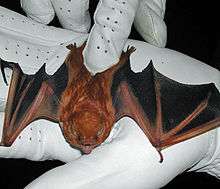Eastern red bat
| Eastern red bat Lasiurus borealis | |
|---|---|
 | |
| Eastern red bat | |
| Scientific classification | |
| Kingdom: | Animalia |
| Phylum: | Chordata |
| Class: | Mammalia |
| Order: | Chiroptera |
| Family: | Vespertilionidae |
| Genus: | Lasiurus |
| Species: | L. borealis |
| Binomial name | |
| Lasiurus borealis Müller, 1776 | |
The eastern red bat (Lasiurus borealis) is a species of bat from the family Vespertilionidae. See also the desert red bat (Lasiurus blossevillii), a related species.
Eastern red bats are widespread across eastern North America, with additional records in Bermuda. It is also scarce but widespread throughout many of the Bahamian islands.
Description
This is a medium-sized Vespertilionid, averaging weights of 9.5–14 g and measurements of 112.3 mm in total length. Adults are usually dimorphic: males have red hair while females are chestnut-colored with whitish frosting on the tips of the fur.
Like most vespertilionids, eastern red bats are insectivorous. Moths (Lepidoptera) form the majority of the diet, but red bats also prey heavily on beetles (Coleoptera), flies (Diptera), and other insects. Echolocation calls have low minimum frequencies, but calls are highly variable ranging from (35–50 kHz). Eastern red bats are best suited for foraging in open spaces due to their body size, wing shape, and echolocation call structure. However, red bats are frequently captured by researchers foraging over narrow streams and roads
Mating likely occurs in late summer or autumn and the sperm is stored in the female's reproductive tract until spring when ovulation and fertilization occurs. In June, females usually give birth to three or four young and then roost with their young until they are weaned. Males roost alone throughout the Summer. High temperature demands associated with gestation and rearing young may limit the northern range for reproductive females. Eastern red bats often roost amongst live or dead leaves on the branches of live hardwood trees, but have also been found using loblolly pine trees in pine plantations.
In late summer, eastern red bats from the northern parts of the range may migrate south for the winter, although little is known about migration routes or overwintering range. In winter, red bats forage for insects on warm nights and even warm days. On warm days during the winter, red bats enter torpor while roosting in the canopy of hardwood or coniferous trees, but during cold bouts they crawl underneath dead leaf litter on the ground and use their furred tail as a blanket.
See also
References
- ↑ Arroyo-Cabrales, J.; Miller, B.; Reid, F.; Cuarón, A.D. & de Grammont, P.C. (2008). "Lasiurus borealis". IUCN Red List of Threatened Species. Version 2009.2. International Union for Conservation of Nature. Retrieved 7 February 2010.
- Ford, W. Mark; Michael A. Menzel; Jennifer M. Menzel; and Dorothy J. (Jan. 2002). Welch Influence of Summer Temperature on Sex Ratios in Eastern Red Bats. American Midland Naturalist' 147(1):179-184.
- Buden, DW. (1986). Distribution of Mammals of the Bahamas. Florida Field Naturalist' 14(3): 53-84.
External links
| Wikimedia Commons has media related to Lasiurus borealis. |
